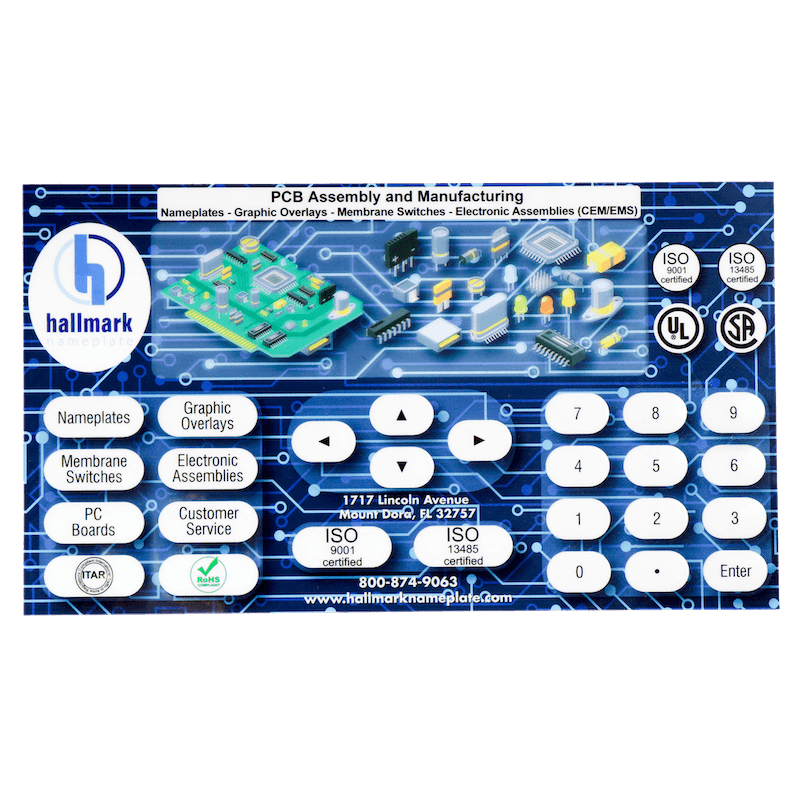Innovative Membrane Switch Solutions for Customized Control Panels
Innovative Membrane Switch Solutions for Customized Control Panels
Blog Article
Comprehending Membrane Layer Switches Over: The Trick to Resilient and Reliable Controls

What Are Membrane Buttons?
Membrane switches are a sophisticated solution in the world of interface technology, combining performance and design perfectly. These devices act as an interface in between customers and electronic systems, integrating several parts into a portable style. Usually created from flexible, slim layers of materials, membrane layer switches are created to react to touch, enabling individuals to communicate with equipment and electronic devices effectively.
The key elements of a membrane button consist of a published circuit layer, visuals overlay, and a spacer layer that avoids unintentional activation. The visuals overlay can be tailored to mirror brand name identity or individual choices, enhancing looks while making sure functionality. Membrane buttons are commonly made use of in different applications, including clinical devices, customer electronic devices, and commercial devices, owing to their resilience and resistance to environmental aspects such as wetness and dirt.
One of the crucial advantages of membrane switches is their capacity to withstand wear and tear, making them suitable for high-traffic atmospheres. In addition, they are lightweight and require very little room, allowing for ingenious layouts in item development. Generally, membrane changes represent a efficient and useful choice for modern electronic interfaces, weding modern technology with user-centric style concepts.
Just How Membrane Layer Changes Job
The procedure of membrane layer switches over joints on a basic yet reliable device that translates customer input right into digital signals. When an individual presses the switch, the top layer warps, enabling a conductive element in the circuit layer to make call with a corresponding conductive pad on the bottom of the visuals overlay.
The layout of membrane layer switches can differ, yet they commonly integrate domes or responsive elements to offer responses to the customer, boosting the total experience - membrane switch. The materials used in membrane layer buttons, such as polyester or polycarbonate, add to their sturdiness and resistance to ecological elements, including wetness and dust. In addition, the published circuits are usually enveloped, which safeguards them from damage with time.
Benefits of Membrane Buttons

Furthermore, membrane buttons are understood for their longevity. Built from durable materials, they are immune to dust, dampness, and physical wear, which substantially expands their lifespan compared to typical mechanical buttons. This toughness makes them especially Home Page suitable for high-traffic settings and applications requiring longevity.
Another substantial benefit is the ease of cleansing and upkeep. The smooth surface of membrane layer switches over reduces dust buildup and is frequently unsusceptible spills, making them suitable for settings that call for constant sanitization.
Furthermore, membrane layer buttons supply a structured profile, bring about a thinner style that can be incorporated into numerous gadgets without adding bulk. This attribute not only boosts the aesthetic charm but additionally adds to a more ergonomic item style.
Applications of Membrane Layer Buttons
Flexible and user-friendly, membrane buttons discover applications across a wide variety of sectors, consisting of clinical tools, customer electronic devices, and industrial tools. In the medical field, these switches are important to devices such as diagnostic equipment, patient surveillance systems, and mixture pumps, where dependability and convenience of cleansing are essential. Their ability to endure extreme atmospheres and keep performance makes them optimal for such applications.

In consumer electronics, membrane layer switches are used in items like microwaves, washing machines, and remote controls - membrane switch. Their sleek design permits instinctive customer interfaces, enhancing the total customer experience while offering resilience and resistance to tear and put on
Commercial equipment additionally gains from membrane layer buttons, specifically in control panels for machinery and automation systems. These switches supply protection against dust and moisture, ensuring consistent performance in challenging settings. In addition, their adjustable attributes enable makers to tailor them to certain operational requirements, improving effectiveness and performance.
Selecting the Right Membrane Layer Change
When picking a membrane layer switch, it is essential to think about numerous elements that affect efficiency internet and viability for specific applications. The key considerations consist of ecological conditions, tactile responses, toughness, and design specs.
First, analyze the operating environment; switches subjected to dampness, chemicals, or extreme temperatures call for certain materials to make certain longevity and performance. Next, examine the demand for tactile comments. Relying on user interaction, some applications may benefit from a tactile response to verify activation, while others may choose a non-tactile style for visual factors.
Durability is an additional vital aspect; membrane layer switches need to be developed to stand up to frequent usage, effects, and abrasion. Make certain the selected button can sustain the expected lifecycle, especially in high-usage situations.

Verdict
In verdict, membrane layer switches over serve as important elements in the design of dependable and durable control systems throughout various industries. The convenience of membrane layer switches enables for tailored services that satisfy details functional needs, enhancing their value in modern-day technology.
Membrane layer switches over represent an important element of contemporary interface style, mixing functionality with strength in different applications.Membrane buttons are an innovative option in the world of customer interface technology, combining performance and design seamlessly. Normally created from adaptable, thin layers of materials, membrane layer buttons are made to react to touch, allowing individuals to connect with machinery and electronic devices effectively.
The style of membrane layer switches can vary, but they typically integrate domes or responsive aspects to provide responses to the customer, enhancing the general experience.In final thought, membrane layer changes offer as vital elements in the design of resilient click here to read and trustworthy control systems throughout different markets.
Report this page